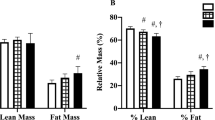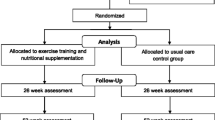Abstract
Purpose
The purpose of the study is to examine changes in muscle strength and self-reported physical functioning in men receiving androgen deprivation therapy (ADT) for prostate cancer compared to matched controls.
Methods
Prostate cancer patients scheduled to begin ADT (n = 62) were assessed within 20 days of starting ADT and 6 and 12 months later. Age and geographically matched prostate cancer controls treated with prostatectomy only (n = 86) were assessed at similar time intervals. Grip strength measured upper body strength, the Chair Rise Test measured lower body strength, and the SF-12 Physical Functioning scale measured self-reported physical functioning.
Results
As expected, self-reported physical functioning and upper body muscle strength declined in ADT recipients but remained stable in prostate cancer controls. Contrary to expectations, lower body muscle strength remained stable in ADT recipients but improved in prostate cancer controls. Higher Gleason scores, more medical comorbidities, and less exercise at baseline predicted greater declines in physical functioning in ADT recipients.
Conclusions
ADT is associated with declines in self-reported physical functioning and upper body muscle strength as well as worse lower body muscle strength relative to prostate cancer controls. These findings should be included in patient education regarding the risks and benefits of ADT. Findings also underscore the importance of conducting research on ways to prevent or reverse declines in physical functioning in this patient population.



Similar content being viewed by others
References
Alibhai SM, Breunis H, Timilshina N, Johnston C, Tomlinson G, Tannock I, Krahn M, Fleshner NE, Warde P, Canning SD (2010) Impact of androgen-deprivation therapy on physical function and quality of life in men with nonmetastatic prostate cancer. J Clin Oncol 28:5038–5045
Basaria S, Lieb J, Tang AM, DeWeese T, Carducci M, Eisenberger M, Dobs AS (2002) Long-term effects of androgen deprivation therapy in prostate cancer patients. Clin Endocrinol 56:779–786
Bertheussen GF, Kaasa S, Hokstad A, Sandmæl JA, Helbostad JL, Salvesen Ø, Oldervoll LM (2012) Feasibility and changes in symptoms and functioning following inpatient cancer rehabilitation. Acta Oncologica 51:1070–1080
Clay CA, Perera S, Wagner JM, Miller ME, Nelson JB, Greenspan SL (2007) Physical function in men with prostate cancer on androgen deprivation therapy. Phys Ther 87:1325–1333
Cohen J (1988) Statistical power analysis for the behavioral sciences. Lawrence Earlbaum Associates, Hillsdale, NJ
Culos-Reed SN, Robinson JW, Lau H, Stephenson L, Keats M, Norris S, Kline G, Faris P (2010) Physical activity for men receiving androgen deprivation therapy for prostate cancer: benefits from a 16-week intervention. Support Care Cancer 18:591–599
Galvao D, Taaffe D, Spry N, Joseph D, Turner D, Newton R (2008) Reduced muscle strength and functional performance in men with prostate cancer undergoing androgen suppression: a comprehensive cross-sectional investigation. Prostate Cancer Prostatic Dis 12:198–203
Galvão DA, Taaffe DR, Spry N, Joseph D, Newton RU (2010) Combined resistance and aerobic exercise program reverses muscle loss in men undergoing androgen suppression therapy for prostate cancer without bone metastases: a randomized controlled trial. J Clin Oncol 28:340–347
Gilbert SM, Kuo Y-f, Shahinian VB (2011) Prevalent and incident use of androgen deprivation therapy among men with prostate cancer in the United States. In: Editor (ed)^(eds) Book Prevalent and incident use of androgen deprivation therapy among men with prostate cancer in the United States. Elsevier, City, pp. 647–653
Godin G, Shephard R Godin leisure-time exercise questionnaire
Godin G, Shephard RJ (1985) A simple method to assess exercise behavior in the community. Can J Appl Sport Sci 10:141–146
Haseen F, Murray LJ, Cardwell CR, O’Sullivan JM, Cantwell MM (2010) The effect of androgen deprivation therapy on body composition in men with prostate cancer: systematic review and meta-analysis. J Cancer Surviv 4:128–139
Heckman JE, Chamie K, Maliski SL, Fink A, Kwan L, Connor SE, Litwin MS (2011) The role of self-efficacy in quality of life for disadvantaged men with prostate cancer. J Urol 186:1855–1861
Herr H, O'Sullivan M (2000) Quality of life of asymptomatic men with nonmetastatic prostate cancer on androgen deprivation therapy. J Urol 163:1743
Joly F, Alibhai S, Galica J, Park A, Yi Q-L, Wagner L, Tannock I (2006) Impact of androgen deprivation therapy on physical and cognitive function, as well as quality of life of patients with nonmetastatic prostate cancer. J Urol 176:2443–2447
Jones CJ, Rikli RE, Beam WC (1999) A 30-s chair-stand test as a measure of lower body strength in community-residing older adults. Res Q Exerc Sport 70:113–119
Katz JN, Chang LC, Sangha O, Fossel AH, Bates DW (1996) Can comorbidity be measured by questionnaire rather than medical record review? Med Care 34:73–84
Levy ME, Perera S, van Londen GJ, Nelson JB, Clay CA, Greenspan SL (2008) Physical function changes in prostate cancer patients on androgen deprivation therapy: a 2-year prospective study. Urology 71:735–739
Newell A, Rosenbloom PS (1981) Mechanisms of skill acquisition and the law of practice. Cognitive skills and their acquisition. Lawrence Earlbaum Associates, Hillsdale, NJ, pp 1–55
Norman GR, Sloan JA, Wyrwich KW (2003) Interpretation of changes in health-related quality of life: the remarkable universality of half a standard deviation. Med Care 41:582–592
Reitan RM, Wolfson D (1985) The Halstead-Reitan neuropsychological test battery: theory and clinical interpretation. Neuropsychology Press, Tucson, AZ
Roberts HC, Denison HJ, Martin HJ, Patel HP, Syddall H, Cooper C, Sayer AA (2011) A review of the measurement of grip strength in clinical and epidemiological studies: towards a standardised approach Age and ageing: afr051
Saylor PJ, Smith MR (2013) Metabolic complications of androgen deprivation therapy for prostate cancer. J Urol 189:S34–S44
Sharifi N, Gulley JL, Dahut WL (2005) Androgen deprivation therapy for prostate cancer. JAMA 294:238–244
Singer JD, Willett JB (2003) Doing data analysis with the multilevel model for change. Applied longitudinal data analysis: modeling change and event occurrence. Oxford university press, pp. 75–123
Smith MR, Saad F, Egerdie B, Sieber PR, Tammela TL, Ke C, Leder BZ, Goessl C (2012) Sarcopenia during androgen-deprivation therapy for prostate cancer. J Clin Oncol 30:3271–3276
Stone P, Hardy J, Huddart R, A'Hern R, Richards M (2000) Fatigue in patients with prostate cancer receiving hormone therapy. Eur J Cancer 36:1134–1141
Uth J, Schmidt JF, Christensen JF, Hornstrup T, Andersen LJ, Hansen PR, Christensen KB, Andersen LL, Helge EW, Brasso K (2013) Effects of recreational soccer in men with prostate cancer undergoing androgen deprivation therapy: study protocol for the ‘FC Prostate’ randomized controlled trial. BMC Cancer 13:595
van Londen GJ, Levy ME, Perera S, Nelson JB, Greenspan SL (2008) Body composition changes during androgen deprivation therapy for prostate cancer: a 2-year prospective study. Crit Rev Oncol Hematol 68:172–177
Ware JE Jr, Kosinski M, Keller SD (1996) A 12-Item Short-Form Health Survey: construction of scales and preliminary tests of reliability and validity. Med Care 34:220–233
Wei JT, Dunn RL, Litwin MS, Sandler HM, Sanda MG (2000) Development and validation of the expanded prostate cancer index composite (EPIC) for comprehensive assessment of health-related quality of life in men with prostate cancer. Urology 56:899–905
Acknowledgments
This work was supported by grants from the National Cancer Institute: R01CA132803 (PI: Jacobsen) and R25CA090314 (PI: Jacobsen). The authors wish to acknowledge the Biostatistics Core at the Moffitt Cancer Center (P30-CA076292; PI: Sellers).
Author information
Authors and Affiliations
Corresponding author
Ethics declarations
The corresponding author is in full control of all primary data and agrees to allow the journal to review the data if requested. The data presented in this manuscript were collected through a protocol approved by the Institutional Review Board of the University of South Florida (Protocol #IRB 106381). All procedures performed in studies involving human participants were in accordance with the ethical standards of the institutional and/or national research committee and with the 1964 Helsinki declaration and its later amendments or comparable ethical standards. This article does not contain any studies with animals performed by any of the authors. Informed consent was obtained from all individual participants included in the study.
Conflicts of interest
The authors have no conflicts of interest to declare.
Disclosures
None.
Rights and permissions
About this article
Cite this article
Gonzalez, B.D., Jim, H.S.L., Small, B.J. et al. Changes in physical functioning and muscle strength in men receiving androgen deprivation therapy for prostate cancer: a controlled comparison. Support Care Cancer 24, 2201–2207 (2016). https://doi.org/10.1007/s00520-015-3016-y
Received:
Accepted:
Published:
Issue Date:
DOI: https://doi.org/10.1007/s00520-015-3016-y




